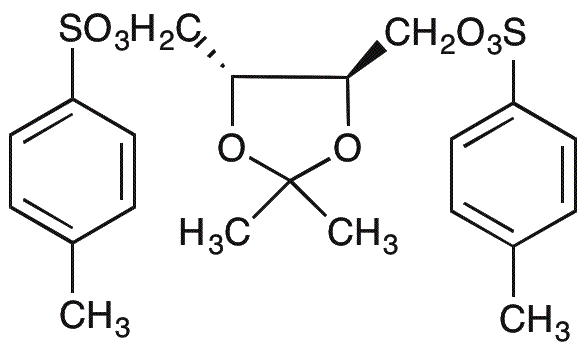1,4-Di-O-tosyl-2,3-O-isopropylidene-D-threitol is widely utilized in research focused on:
- Synthetic Organic Chemistry: This compound serves as a versatile intermediate in the synthesis of various complex organic molecules, enabling researchers to create new compounds with specific properties.
- Pharmaceutical Development: It is used in the development of pharmaceuticals, particularly in the synthesis of sugar derivatives that can enhance drug delivery systems or improve bioavailability.
- Biochemical Research: The compound aids in studying carbohydrate chemistry, allowing scientists to explore the structure-activity relationships of glycosylated compounds.
- Material Science: It finds applications in creating novel materials, such as polymers or coatings, that require specific chemical functionalities for enhanced performance.
- Analytical Chemistry: This chemical is employed in various analytical techniques, including chromatography, to separate and identify different compounds in complex mixtures.
General Information
Properties
Safety and Regulations
Applications
1,4-Di-O-tosyl-2,3-O-isopropylidene-D-threitol is widely utilized in research focused on:
- Synthetic Organic Chemistry: This compound serves as a versatile intermediate in the synthesis of various complex organic molecules, enabling researchers to create new compounds with specific properties.
- Pharmaceutical Development: It is used in the development of pharmaceuticals, particularly in the synthesis of sugar derivatives that can enhance drug delivery systems or improve bioavailability.
- Biochemical Research: The compound aids in studying carbohydrate chemistry, allowing scientists to explore the structure-activity relationships of glycosylated compounds.
- Material Science: It finds applications in creating novel materials, such as polymers or coatings, that require specific chemical functionalities for enhanced performance.
- Analytical Chemistry: This chemical is employed in various analytical techniques, including chromatography, to separate and identify different compounds in complex mixtures.
Documents
Safety Data Sheets (SDS)
The SDS provides comprehensive safety information on handling, storage, and disposal of the product.
Product Specification (PS)
The PS provides a comprehensive breakdown of the product’s properties, including chemical composition, physical state, purity, and storage requirements. It also details acceptable quality ranges and the product's intended applications.
Certificates of Analysis (COA)
Search for Certificates of Analysis (COA) by entering the products Lot Number. Lot and Batch Numbers can be found on a product’s label following the words ‘Lot’ or ‘Batch’.
Número de catálogo
Número de lote/lote
Certificates Of Origin (COO)
This COO confirms the country where the product was manufactured, and also details the materials and components used in it and whether it is derived from natural, synthetic, or other specific sources. This certificate may be required for customs, trade, and regulatory compliance.
Número de catálogo
Número de lote/lote
Safety Data Sheets (SDS)
The SDS provides comprehensive safety information on handling, storage, and disposal of the product.
DownloadProduct Specification (PS)
The PS provides a comprehensive breakdown of the product’s properties, including chemical composition, physical state, purity, and storage requirements. It also details acceptable quality ranges and the product's intended applications.
DownloadCertificates of Analysis (COA)
Search for Certificates of Analysis (COA) by entering the products Lot Number. Lot and Batch Numbers can be found on a product’s label following the words ‘Lot’ or ‘Batch’.
Número de catálogo
Número de lote/lote
Certificates Of Origin (COO)
This COO confirms the country where the product was manufactured, and also details the materials and components used in it and whether it is derived from natural, synthetic, or other specific sources. This certificate may be required for customs, trade, and regulatory compliance.


